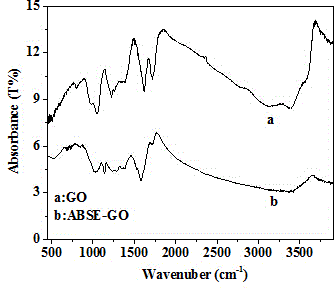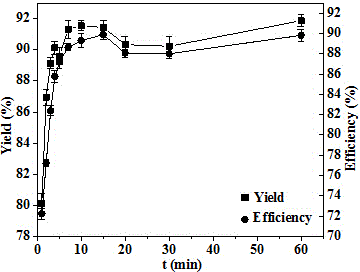Preparation method and application of functionalized graphene oxide carrier
A graphene and functionalization technology, applied in chemical instruments and methods, immobilized on or in inorganic carriers, carrier-bound/immobilized peptides, etc., can solve the structural modification of graphene oxide, hinder the widespread use of enzymes, and cannot be reused and other problems, to achieve the effect of increasing the degree of freedom of swing, wide application range and strong applicability
- Summary
- Abstract
- Description
- Claims
- Application Information
AI Technical Summary
Problems solved by technology
Method used
Image
Examples
Embodiment 1
[0037] Example 1 Immobilized cellulase
[0038] Weigh 1g of graphite powder and dissolve it in 25ml of concentrated sulfuric acid (ice bath), add 1g of NaNO 3 , 3 g KMnO 4 , after which the mixture was heated to 35 o C, continue stirring for 30 min, add 50 ml of distilled water, raise the temperature of the reactant to 90°C, continue stirring for 1 h, add 40 ml of distilled water and 3 ml of 30% hydrogen peroxide to terminate the reaction, and The reactant was filtered and washed with distilled water, and the product was resuspended in distilled water for 5 min and then vacuum-dried at 40°C to obtain graphene oxide.
[0039] figure 1 SEM and TEM images of graphene oxide prepared above. From the SEM and TEM images, it can be seen that graphene oxide has a sheet structure with a large surface area, wrinkles of different degrees, and a large protein load.
[0040] Weigh 0.5 g SESA and dissolve in 5 ml distilled water at 40 °C with 1.0 M Na 2 CO 3 Adjust the pH of the so...
Embodiment 2
[0044] Example 2 Immobilized penicillin G acylase
[0045] The preparation of the functionalized graphene oxide carrier is the same as in Example 1.
[0046] Weigh 11 parts of functionalized graphene oxide, each 25mg, add 0.3ml of liquid penicillin G acylase, then add 0.7ml of phosphate buffer (0.1 M, pH 6.0), react for 1min, 2min, 3min, 4min respectively , 5min, 7min, 10min, 15min, 20min, 30min, 60min, after the reaction, centrifuge, take 0.8ml of supernatant, then add 1ml of phosphate buffer (0.1 M, pH 6.0), centrifuge, take 0.9ml of supernatant ml, then add 1ml of citric acid buffer (0.1 M, pH 6.0), centrifuge, remove all the supernatant, use the Bradford method to measure the protein content in the first two supernatants respectively, and use the PDAB method to determine the above-mentioned immobilized penicillin G Acylase activity.
[0047] Depend on Figure 4 , it can be seen that with the increase of immobilization time, the immobilization yield and immobilization ...
Embodiment 3
[0048] Example 3 Immobilized bovine serum albumin
[0049] The preparation of the functionalized graphene oxide carrier is the same as in Example 1.
[0050] Weigh 11 parts of functionalized graphene oxide, 25 mg each, add 0.8 ml of bovine serum albumin, then add 0.2 ml of phosphate buffer (0.1 M, pH 7.0), and react for 1 min, 2 min, 3 min, 4 min, 5 min, respectively. 7min, 10min, 15min, 20min, 30min, 60min, after the reaction, centrifuge, take 0.8ml of supernatant, then add 1ml of phosphate buffer (0.1 M, pH 7.0), centrifuge, take 0.8ml of supernatant, and then Add 1ml of citric acid buffer (0.1 M, pH 7.0), centrifuge to remove all the supernatant, and use the Bradford method to measure the protein content in the first two supernatants respectively.
[0051] Depend on Figure 5 It can be seen that within 10 min, with the increase of immobilization time, the immobilization yield of bovine serum albumin increases. When the immobilization time reaches 10 min, as the time con...
PUM
 Login to View More
Login to View More Abstract
Description
Claims
Application Information
 Login to View More
Login to View More - R&D
- Intellectual Property
- Life Sciences
- Materials
- Tech Scout
- Unparalleled Data Quality
- Higher Quality Content
- 60% Fewer Hallucinations
Browse by: Latest US Patents, China's latest patents, Technical Efficacy Thesaurus, Application Domain, Technology Topic, Popular Technical Reports.
© 2025 PatSnap. All rights reserved.Legal|Privacy policy|Modern Slavery Act Transparency Statement|Sitemap|About US| Contact US: help@patsnap.com



